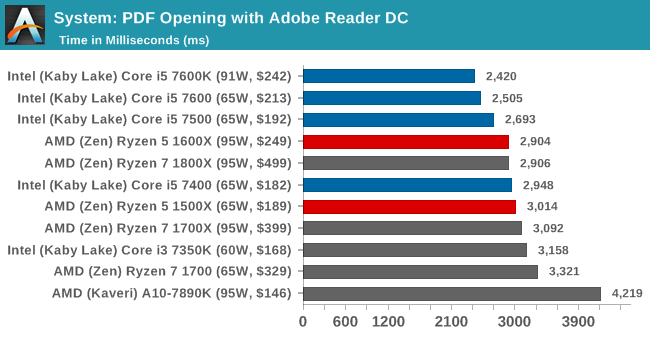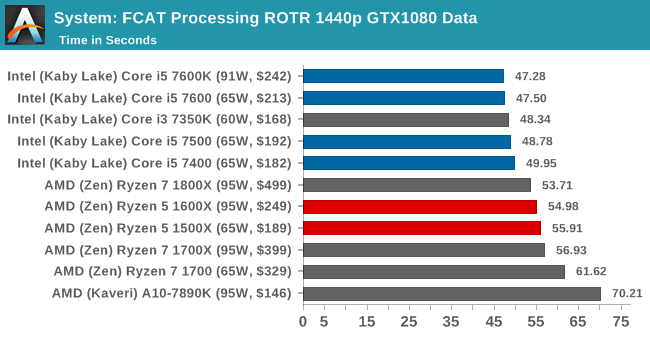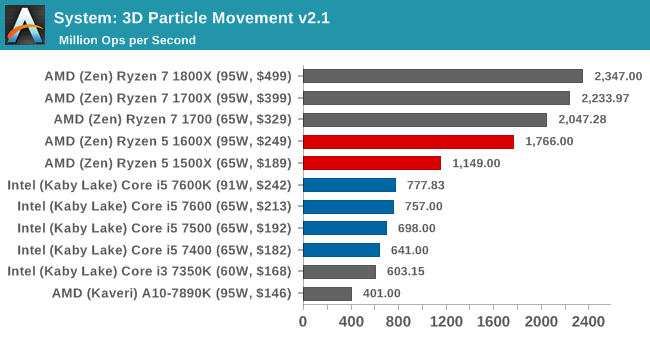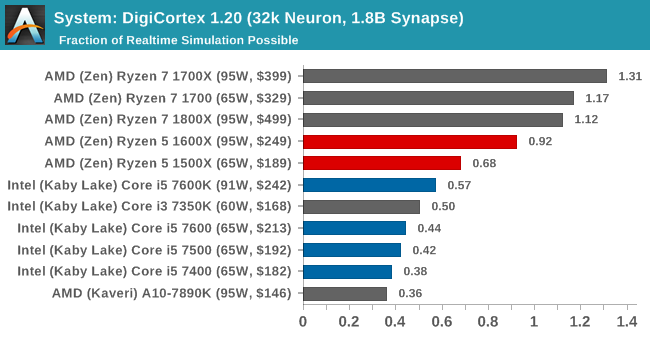The AMD Ryzen 5 1600X vs Core i5 Review: Twelve Threads vs Four at $250
by Ian Cutress on April 11, 2017 9:00 AM ESTBenchmarking Performance: CPU System Tests
Our first set of tests is our general system tests. These set of tests are meant to emulate more about what people usually do on a system, like opening large files or processing small stacks of data. This is a bit different to our office testing, which uses more industry standard benchmarks, and a few of the benchmarks here are relatively new and different.
PDF Opening
First up is a self-penned test using a monstrous PDF we once received in advance of attending an event. While the PDF was only a single page, it had so many high-quality layers embedded it was taking north of 15 seconds to open and to gain control on the mid-range notebook I was using at the time. This put it as a great candidate for our 'let's open an obnoxious PDF' test. Here we use Adobe Reader DC, and disable all the update functionality within. The benchmark sets the screen to 1080p, opens the PDF to in fit-to-screen mode, and measures the time from sending the command to open the PDF until it is fully displayed and the user can take control of the software again. The test is repeated ten times, and the average time taken. Results are in milliseconds.

Opening PDFs using Adobe is significantly single threaded, hence why Intel takes the win here for the most part - the 7400 is slightly lower on frequency, enough for the 4.0 GHz Ryzen parts to push ahead.
FCAT Processing
One of the more interesting workloads that has crossed our desks in recent quarters is FCAT - the tool we use to measure stuttering in gaming due to dropped or runt frames. The FCAT process requires enabling a color-based overlay onto a game, recording the gameplay, and then parsing the video file through the analysis software. The software is mostly single-threaded, however because the video is basically in a raw format, the file size is large and requires moving a lot of data around. For our test, we take a 90-second clip of the Rise of the Tomb Raider benchmark running on a GTX 980 Ti at 1440p, which comes in around 21 GB, and measure the time it takes to process through the visual analysis tool.
Similarly, FCAT is single threaded as it analyzes frame-by-frame. The extra frequency helps Intel here.
3D Particle Movement v2.1
This is the latest version of the self-penned 3DPM benchmark. The goal of 3DPM is to simulate semi-optimized scientific algorithms taken directly from my doctorate thesis. Version 2.1 improves over 2.0 by passing the main particle structs by reference rather than by value, and decreasing the amount of double->float->double recasts the compiler was adding in. It affords a ~25% speed-up over v2.0, which means new data.
DigiCortex 1.20
Despite being a couple of years old, the DigiCortex software is a pet project for the visualization of neuron and synapse activity in the brain. The software comes with a variety of benchmark modes, and we take the small benchmark which runs a 32k neuron/1.8B synapse simulation. The results on the output are given as a fraction of whether the system can simulate in real-time, so anything above a value of one is suitable for real-time work. The benchmark offers a 'no firing synapse' mode, which in essence detects DRAM and bus speed, however we take the firing mode which adds CPU work with every firing.
Agisoft Photoscan 1.0
Photoscan stays in our benchmark suite from the previous version, however now we are running on Windows 10 so features such as Speed Shift on the latest processors come into play. The concept of Photoscan is translating many 2D images into a 3D model - so the more detailed the images, and the more you have, the better the model. The algorithm has four stages, some single threaded and some multi-threaded, along with some cache/memory dependency in there as well. For some of the more variable threaded workload, features such as Speed Shift and XFR will be able to take advantage of CPU stalls or downtime, giving sizeable speedups on newer microarchitectures.

Because parts of Photoscan are very multithreaded, such as the first stage, there's plenty of scope for the Ryzen CPUs to pull ahead here.













254 Comments
View All Comments
msroadkill612 - Thursday, April 13, 2017 - link
Its worth noting that amd moboS historically tend to endure many revised cpuS. whereas an intel cpu upgrade for a user is bound to require a new mobo."ryzen 2" will probably simply drop into an am4 mobo.
Its also interesting that many or all the mobos i have seen are ready to go for an apu - video connects onboard e.g.
this indicates that raven ridge exists now, for pre-production mobo testing.
msroadkill612 - Thursday, April 13, 2017 - link
I dont believe amd would go to all the trouble of doing zen and vega, and then merge zen with prev gen polaris for the APU.it doesnt make sense from several perspectives. amd philosophy, the architecture seen in ryzen - 2 zen core blocks on a ccx simply becomes one core block and one vega gpu on a single ccx.
it will be a hell of a piece of silicon.
Johan Steyn - Friday, April 14, 2017 - link
Ryzen 9 is not that far fetched. Looking at the server part coming soon, an Ryzen extreme could be happening, especially for workstations. Maybe it might even fit AM4, although unlikely with quad channels. I do not think the current SOC has enough pins. So maybe we might get a Ryzen 9 with plenty of cores and quad channel memory.drajitshnew - Friday, April 14, 2017 - link
Dear Ian,Please clarify a point. You have mentioned that both AMD & Intel have 16 CPU PCIe lanes, but AMD offers 4 pcie lanes for storage from the CPU. If the chipset is loaded this could have an impact on the following 3 situations,
1. If the motherboard manufacturer routes those lanes from m2 to PCIe. Then those could be used, as storage, adding a GPU for GPGPU or a 10GbE NIC for use for a UHD media server, or AIC format storage.
2. With a heavily loaded chipset, a NVMe drive like a 1 TB samsung 960 pro or comparable, may show improved performance, specially in sequential transfers.
3. For a long lived system a large X-point or Z-nand or 3d SLC may show significant latency advantages.
cvearl - Sunday, April 16, 2017 - link
You have odd 480 results on GTA V. Are you using the final run (with the jet) from the built in test? My 480 scores in the mid 70's using your settings on that run with an i7 2600k.cvearl - Sunday, April 16, 2017 - link
Looking back at my GTX 1060 SC results (before I replaced with my 480) It had similar results to what you show here (Assuming the final run of the built in test). Am I to understand that the 480 gets a better result on i7 than Ryzen?Polacott - Monday, April 17, 2017 - link
my experience with AMD processors is that they have aged perfectly. I mean the AMD processors got more support and performance as apps and SO has been prepared to take advantage of more threads as years passed. I would get the Ryzen 1600X without any doubts over the i5.rmlarsen - Monday, April 17, 2017 - link
Unfortunate typo: In the conclusion it says "Looking at the results, it’s hard to notice the effect that 12 threads has on multithreaded CPU tests. " I believe the author meant to write "it's hard NOT to notice".Kamgusta - Tuesday, April 18, 2017 - link
Why in the Earth nobody ever considers the i7-7700?!?! And keep on putting the Ryzen CPUs only against the i5-7600K and/or the i7-7700K?i7-7700 has the same clocks as the i5-7600K, but double the threads and 2MB more L3. It consumes a lot less power than the i7-7700K and no more power than the i5-7600K. You can picture it as a more powerful i5-7600K or as a slight less powerful i7-7700K (but far more efficient).
If anyone is torn between R6-1600 and i5-7600K then the i7-7700 is, quite ironically, the best choice.
Ratman6161 - Tuesday, April 18, 2017 - link
So over the weekend I upgraded my system from an i72600K to a Ryzen 5 1600. First off, I could care less about gaming so I'll put that out there up front. I can buy (in order of real world price)i7 7700K for $300
ryzen 1600x would have been $249
Ryzen 5 1600 was $219
i5 7600K for $210.
I went with the R5 1600. For highly multi threaded tasks (remembering I don't care anything about games about games) the six core R5's compare very favorably with the i7 7700K even though most of the comparisons you see match them up against the i5. And the big difference between the 1600 and the 1600X is clock speed...and they are unlocked. So for me the 1600 ended up being a no-brainer.
So for us non-gamers anyway, i'd disagree with the i7 7700K being the best choice.
Also, when comparing prices, look at the platform price including motherboards. I got an Asrock AB350 Pro 4 for $39 bundled with the CPU so total price $258. Cheapest 7600K bundle at the same place: $315, cheapest 7700K bundle $465.